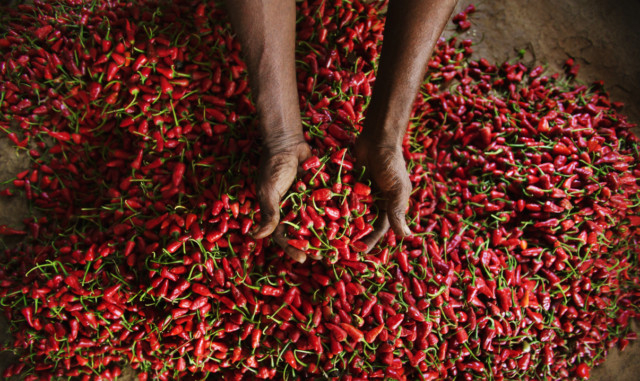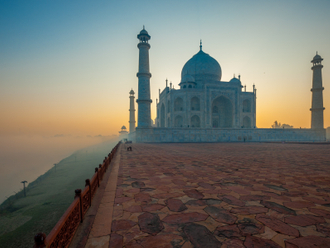
The world knows Indian food as a heady mix of warm spices and fresh ingredients. Less known is the fact that many staple ingredients used today were not originally grown in India, but were first introduced to the nation by tourists and invaders.
From 1500BC to the present day, Indian food has been influenced by countries in Europe, Asia, the Middle East, and even Latin America. The citizens of Greece, Portugal, Mongolia, Holland and England arrived on Indian soil as traders, settlers and colonisers, bringing with them a multitude of culinary practices and an assortment of dishes that subsequently became an inextricable part of the country’s cuisine.
Take for instance, the Aryan invasion thousands of years ago. The Aryans introduced the concept of a balanced diet to India, based on the principle that ailments were linked to lifestyle. By making the right choices with regard to food, spices and nutrition, one could keep maladies in check and create a sense of harmony between body and mind. A balanced Indian meal today accordingly incorporates six tastes: sweet, sour, salty, bitter, pungent and astringent, which together meet daily dietary requirements, and satisfy one’s taste buds.
According to Colleen Taylor Sen, a Canada-based food writer and the author of Food Culture in India (2004) and Curry: A Global History (2009), the most significant stamp on Indian food was left by the Portuguese, who came to India at the end of the 15th century. She writes in Food Culture in India, “Never in history has a single country — and such a tiny one at that — so profoundly affected the eating habits of the entire world.”
“Today it’s hard to imagine Indian cuisine without potatoes, tomatoes, papayas, pineapples, peanuts and chilli peppers, all introduced by the Portuguese in what is called the ‘Columbian exchange,’” she says in an interview with GN Focus.
Apart from introducing a host of ingredients, the Portuguese showed Indians how to curdle milk, which subsequently became the mainstay of many vegetarian dishes and also of the famous Bengali sweets industry.
Mugdha Savkar, a Mumbai-based food researcher, notes that Portuguese influences are also seen in ritualistic Hindu vegetarian meals. “On a fasting day one is normally allowed to consume food prepared using potatoes, sweet potatoes and nuts. The reason for this is that the principles of fasting were laid down during the Vedic Age and they did not allow consumption of any vegetables or fruits grown during that time period; hence the ‘New Age vegetables’ such as potatoes are conveniently consumed without guilt, as they never featured in the fasting rules,” she says.
The Mogul influence
Closer home, food researchers and historians unanimously agree that Indian cuisine would not have gained the same versatility had it not been for the Moguls (1526 to 1757). The Moguls were known for their grandeur and this opulence was reflected in their food: their mastery of ingredients changed the way Indians cooked. They introduced new techniques and creative ways to use spices.
From the tandoor oven and the dum pukht technique, where food is cooked slowly in a sealed pot, to Rajasthan’s famed khad method (literally, cooking in a pit), the Moguls introduced several new cooking techniques in India. They also taught natives how to pep up a dish with the generous use of nuts, dry fruits and green herbs. They gave the land its popular kebabs, biryanis, samosas, yeast-based breads such as nan and kulcha, sweetened drinks such as sherbet and Indian sweets such as kulfi and jalebis.
As the empire expanded, royal chefs incorporated spices and ingredients from regional centres, creating a hybrid and diverse cuisine. Nilesh Limaye, a Mumbai-based restaurateur and author of several cook books, including the Good Morning Cookbook, explains: “Be it in the Malabar region and Hyderabad in the south, Aurangabad in central India or Awadh (Lucknow) and Delhi in the north, Mughlai food was well blended with local cuisines, using regional and seasonal ingredients.”
Taylor Sen points out that the Mogul influence on Indian food is a complex issue; it is not a simple combination of Persian and Indian ingredients and techniques. “North Indian cuisine,” she explains, “incorporated elements from other regions, including Central Asia, Afghanistan, North Africa, and the Middle East. This borrowing took place when North India was ruled by different Turkish, Afghan and Central Asian dynasties, whose courts became a magnet for people from the entire Islamic world.”
Global influences
Although the Dutch and French influences on Indian food are not as pronounced as the Portuguese and Persian, they also helped make Indian cuisine diverse. The juxtaposition of East and West gave birth to numerous recipes that remain popular in India.
“The Dutch gave us a staple without which our mornings and teatimes are incomplete: bread,” says Savarkar (although this is a point hotly disputed by historians, who insist it was the Portuguese who first brought bread to India’s western shores). “The Dutch introduced bread loaves and cakes in India using dough and batter comprising eggs and butter. The French influence, though more varied than the Dutch, is however confined to Puducherry in South India,” she adds.
Taylor Sen agrees, while pointing out: “A fascinating question is — what would have happened to Indian and French cuisine if the French had defeated the British in 1757 and retained their dominance? Alas, we shall never know and the French culinary legacy is minimal, although some chefs in Puducherry are now trying to revive it.”
The British and their nearly 200 years of colonial rule played a significant role in the evolution of Indian food. They imported new vegetables such as cauliflowers and cabbages, but many believe that their main contribution to Indian food history is tea.
“Although tea used to grow wild in Assam, it was not drunk in the sub-continent until the British imported tea plants from China in the mid 19th century and established plantations in Assam, Darjeeling and elsewhere,” says Taylor Sen.
Limaye observes: “Britons never imposed their cuisine upon Indians and stepped away from our spicy foods. So even if black peppercorn is to be blamed for the British presence in India — who are said to have come searching for them — they never quite adjusted to our cuisine, and Indians also never accepted bland British food.”
The cultural interaction, however, created an interesting hybrid: Anglo-Indian cuisine, which was mostly the creation of Indian bawarchis or cooks who worked for the British gentry. They slowly added spices to their preparations and gradually got the British accustomed to the zesty flavours of Indian spices.
Chitra Ghose, a Delhi-based food consultant with several top Indian hotel chains, says the concept of fusion cooking started with the Indianisation of British food. “The Indian railways and the military were the strongholds of the British and they popularised this fusion cuisine. Coronation chicken curry, devised on the coronation of King George V, the Queen’s favourite trifle pudding, Lord Cornwallis steaks and Company Bahadur special mutton cutlets are a few of the curious names of such cultural exchanges; some of which are popular even today.” Other English contributions are chops, patties (flaky pastries with stuffing) and omelettes.
Another influence, without which any map of India’s culinary landscape will never be complete, is China. In the 1950s, Kolkata was home to more than 80,000 Chinese. After the India-China war in the early 1960s, though many Indian-Chinese emigrated abroad, the cuisine never lost its popularity in India. While Chinese taught Indians how to stir-fry and use sauce and cornstarch to cook, Indian chefs went a step further and created a range of dishes using Indian cooking practices — adding lots of ginger and garlic, coriander and sliced chillies — which were more palatable to local taste buds. Cauliflower Manchurian, hakka noodles, sweet and sour chicken, fried rice and chilli chicken are some examples of the Indianisation of Chinese food.
Easy availability of ingredients — be it Japanese, Thai, Italian or Mediterranean — in recent years has made experimenting with food easy. As palates change and Indians warm up to trying different fares, fusion cuisine seems to be increasingly gaining traction and lending Indian food a distinct global character.






